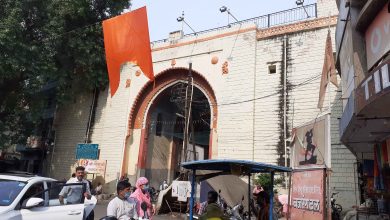63 Buildings Around Nagpur Airport Pose Hurdles to Flight Path

What is the Issue with Buildings Around Nagpur Airport?
The Scope of the Problem (Nagpur airport building obstructions)
Nagpur’s airport has identified 63 buildings that are obstructing its flight path. These buildings pose both physical and communication challenges for aircraft. Previously, 68 structures were listed as hurdles, but recent efforts have led to the removal of five of them. However, the remaining 63 continue to pose a threat to aviation safety.
How Buildings Affect Flight Paths
Buildings taller than a specified limit within certain zones near the airport disrupt both the physical flight paths and the radio communication between planes and ATC. The final descent of an aircraft is particularly sensitive to any obstruction since the plane is flying at lower altitudes, which increases the risk of interference.
The RTI Act and Findings
The Role of RTI Activism
Abhay Kolarkar, a noted Right to Information (RTI) activist, filed an inquiry with the Airports Authority of India (AAI) to gather more information on the obstacles posed by these buildings. The query revealed important insights into how the buildings were categorized and the ongoing efforts to remove them. However, much of the information was routed through Mihan India Limited (MIL), the operator of Nagpur Airport.
Key Details from the RTI Response
MIL’s response to the RTI query clarified that although 68 structures were initially flagged as obstacles, five have since been removed. However, 63 buildings still remain. This ongoing issue emphasizes the complexity of removing or altering buildings that exceed height limits.
How Are Hurdles Identified?
Color-Coded Zoning and Height Restrictions
The identification of hurdles is not arbitrary. A color-coded map is used to mark different zones around the airport, with each zone having specific height restrictions. The red zone, for instance, has the most stringent limits, as even a slight increase in a building’s height could interfere with flight operations. Buildings are evaluated based on a formula that considers their exact coordinates and their proximity to the airport.
Minor vs. Major Violations
Not all hurdles require the demolition of an entire building. In some cases, minor violations—such as an extra room or a water tank built on the roof—can be corrected by removing just those structures. However, if a building has an entire floor that exceeds the permitted height, the removal process becomes far more complicated, often requiring significant demolition work.
The Safety Risks of These Buildings (Nagpur airport building obstructions)
Communication Interference
One of the most critical issues caused by these buildings is the potential for communication blackouts between aircraft and ATC. Pilots rely on constant communication with the ground to navigate the last phase of their descent safely. Tall structures can disrupt these signals, causing momentary communication gaps that could prove dangerous.
Obstructing the Flight Path
Apart from communication issues, these buildings also pose a physical threat to aircraft. Any object that stands too tall in the flight path could result in a collision or force pilots to take sudden corrective measures, increasing the risk of accidents.
What Actions Are Being Taken?
Notices to Building Owners
MIL has sent notices to the owners of the 63 buildings that remain as obstacles, urging them to comply with regulations and remove any violating structures. However, compliance has been slow, and as of the latest reports, none of the owners have taken sufficient action to address the problem.
Coordination with DGCA
MIL has also shared the list of obstructions with the Directorate General of Civil Aviation (DGCA), the regulatory body responsible for overseeing aviation safety. The DGCA is now involved in efforts to resolve the issue, but the timeline for removing these hurdles remains uncertain.
What Can Be Done to Resolve the Issue?
Voluntary Compliance by Building Owners
One of the quickest ways to address the problem would be for the building owners to voluntarily comply with the height restrictions. In many cases, compliance can be achieved with minimal alterations, such as removing a water tank or lowering the height of a roof.
Legal Action
If voluntary compliance is not forthcoming, legal action may be the next step. MIL and the DGCA have the authority to enforce regulations and could take measures to demolish parts of buildings that violate height restrictions. However, this is often a lengthy and costly process.
How Are Buildings Approved for Construction?
The No-Objection Certificate (NOC) Process
Before constructing a building near the airport, developers are required to obtain a No-Objection Certificate (NOC) from the AAI. This process ensures that new buildings will not pose any risk to flight operations. However, some of the existing structures may have been built before these regulations were strictly enforced, leading to the current issues.
NOC Compliance and Violations
Despite the NOC process, some builders have constructed structures that exceed the permitted height, either intentionally or due to misunderstandings. This has led to the need for retrospective action to bring these buildings into compliance with current regulations.
The issue of buildings obstructing the flight path at Nagpur Airport is a serious one that requires immediate attention. While some progress has been made with the removal of five structures, 63 buildings still pose significant safety risks. The involvement of the DGCA, MIL, and the AAI in addressing the problem is encouraging, but the resolution process is likely to be slow. It is crucial for building owners to comply with regulations and for authorities to take swift action to ensure the safety of all flights in and out of Nagpur.
1. What makes buildings around airports a safety concern?
Buildings that exceed height restrictions near airports can obstruct the flight path and interfere with communication between aircraft and air traffic control, posing serious safety risks.
2. How are height restrictions determined around airports?
Height restrictions are calculated using a formula based on the building’s coordinates and proximity to the airport. Zones are color-coded, with stricter limits applied in areas closest to the airport.
3. Can small violations like water tanks be corrected?
Yes, in many cases, minor violations such as water tanks or extra rooms can be corrected without demolishing the entire building.
4. Who is responsible for enforcing these regulations?
The Airports Authority of India (AAI), Mihan India Limited (MIL), and the Directorate General of Civil Aviation (DGCA) are responsible for enforcing building regulations near Nagpur Airport.
5. What happens if a building owner doesn’t comply?
If voluntary compliance is not achieved, legal action may be taken to enforce the demolition or modification of parts of the building that exceed height restrictions.









